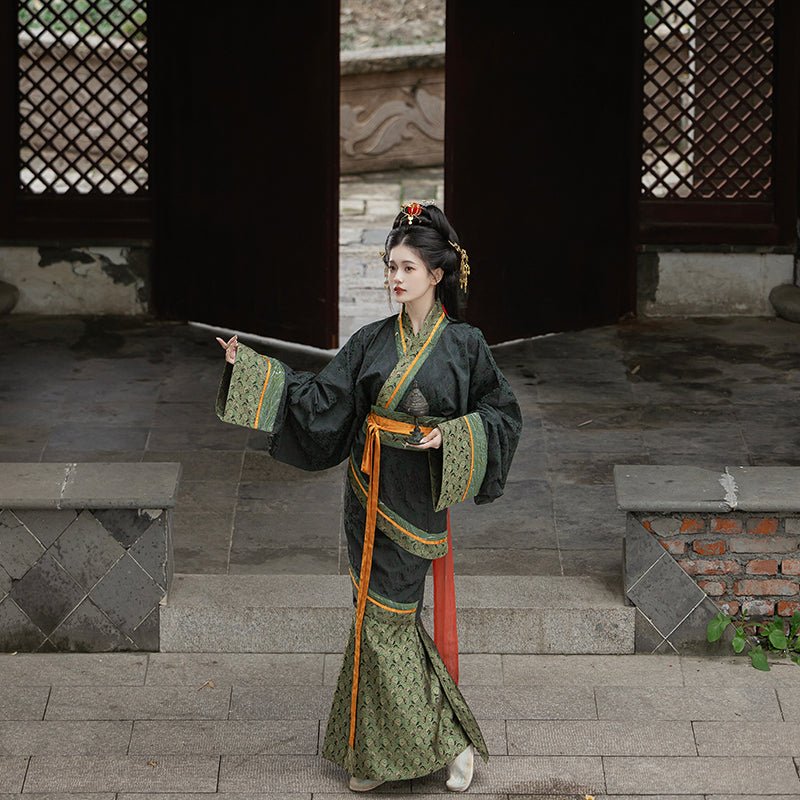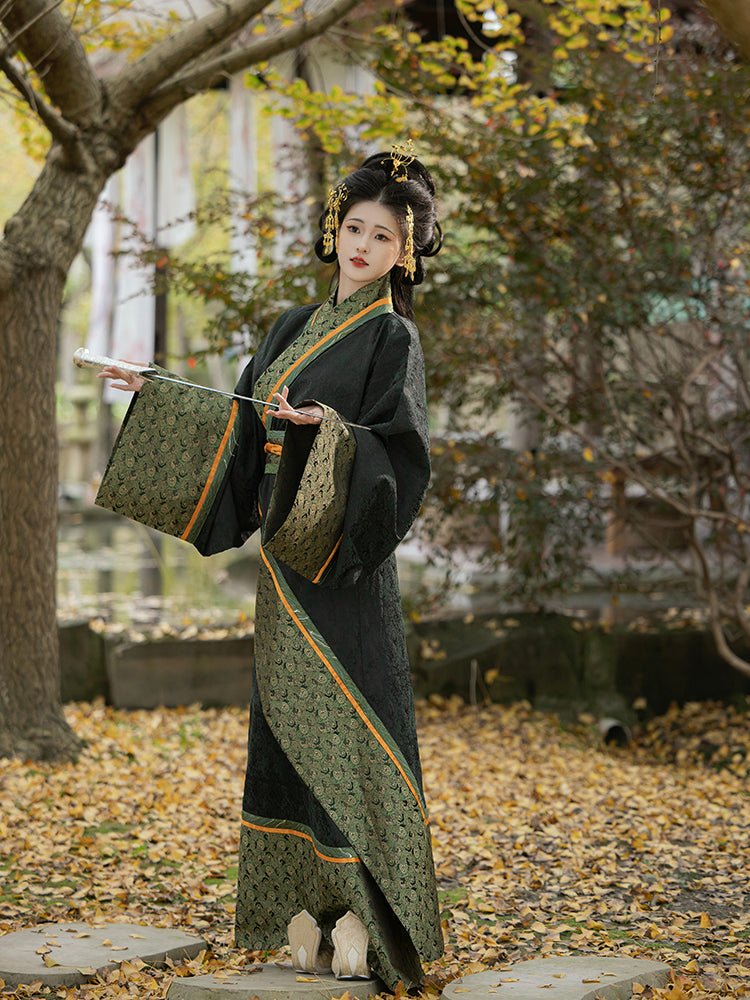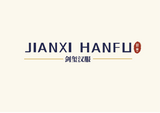This Qin-Han style Quju robe named "Dian Qi" draws inspiration from cultural relics unearthed from the Mawangdui Han Tombs. Crafted from black damask-like fabric imitating Shu brocade, it adopts an iridescent jacquard technique: the base cloth is a calm black, while the jacquard part is an elegant green. As the viewing angle changes, the presentation of the patterns also varies, exuding an overall air of elegance and luxury. The neckline and cuffs are made by splicing multi-colored fabrics, with distinct layers and exquisite craftsmanship. When matched with the main black fabric, they appear more solemn and antique, as if bearing the weight of history. There are two styles of this Quju robe to choose from: one is the classic Quju robe, and the other is the mermaid-style Quju — it has to be said that both styles are extremely attractive, and wearing them feels like traveling back to the Qin-Han era 2,200 years ago in an instant.
Notice:
1.This is an in stock style. It will be dispatched 3 days after the order is placed. If you have any questions, please contact us.
2.The set includes: a Quju robe / a mermaid skirt robe + a Waist Belt.
Please note that the pattern print is not fixed, the position will be random and differ from the product images.
-
Warring States Shenyi (Source)
Represented by the No.15 Brocade Robe (Mashan Chu Tomb, Jiangling, Hubei), it featured a cross-collar with right overlap and Quju wrapping (forming triangular "extended lapel hooks"). Made by joining separate upper/lower parts, it was full-coverage but impractical for movement—only for rituals.
-
Qin-Han Robe Differentiation
-
Quju robes (Early Western Han mainstream): Inherited wrap-around design (e.g., Scarlet Rhombus-patterned Gauze Robe, Mawangdui Tomb) with flared hems. Worn in 3 layers (outer curved, middle straight, inner unlined) as noble ceremonial attire.
-
Zhiju robes (Eastern Han mainstream): Vertically cut (e.g., Plain Gauze Robe, Mawangdui Tomb). Popularized after crotch trousers spread (no need to cover lower body), becoming daily wear for officials/commoners and even court attire.
-
Tech & Materials
-
Silk: Mawangdui’s Plain Gauze Robe weighed 49g (12g/sq.m), with silk 30% finer than modern silkworms. Brocades used "four-harness warp weave" (e.g., geometric pile brocade)—exclusive to nobles.
-
Linen: Mawangdui linen had 37 threads/cm (near modern fine linen). Zhou’s ban on "trading embroidered silks" was lifted; merchants/servants could wear trimmed silk shoes.
-
Class-Based Attire
- Nobles: Lady Xin Zhui’s (Mawangdui) Scarlet Rhombus-patterned Robe (cinnabar-dyed, pile brocade trim).
- Qin soldiers: Short Zhiju robes (under armor)—balanced ritual and practicality.
-
Cultural Marker
The Book of Rites emphasized "right-overlap = orthodox"; Han Dynasty saw left-overlap collars as "barbarian" (Xiongnu, Xianbei). Evidence (Mawangdui figurines, Qin terracotta) confirms right-overlap as core of Huaxia attire.
-
Straight-Lapel Popularity Logic
It reflected a shift from "ritual priority" to "practicality": With crotch trousers, straight-lapel robes suited daily use—officials wore black-trimmed court versions, commoners wore short-lapel styles, covering "court to marketplace".
Qin-Han robes combined form differentiation (Quju-curved for ritual, Zhiju-straight for convenience), fabric stratification (silk/brocade for nobles, linen for commoners), and symbol unification (right-overlap collars). They turned Warring States’ ritual "shenyi" into universal attire—from Mawangdui’s gauze robes to Eastern Han stone-carved "Chanyu court robes", embodying "governing via ritual attire" and becoming a core Chinese clothing gene.
About The Brand: 卿如故
A Haven for 192,000 Hanfu Aficionados
Featured Products: Reviving Ancient China Grandeur with Time-Honored Craft
✅ Diverse Silhouettes + Signature Collections
Spanning from Ming Dynasty Pifeng (grand robes with phoenix motifs) to Yisan (mid-length jackets), Zhiju (straight robes) to Song Dynasty Beizi — we blend Ming-style authenticity and modern wearability. Must-have lines include:
The regal “Zhaodian Hong” Ming-style Gown (renowned for rich red brocade and intricate floral embroidery).
The elegant “Hei Yu” Black Silk Pifeng (adorned with gold-threaded cloud patterns).
The bestselling “Jin Xi” Jin-style Set — ideal for traditional weddings, cultural ceremonies, or daily Hanfu styling.
✅ Design Highlights: “Ming Elegance, Reimagined”
We use premium materials (silk brocade, linen blends) and meticulous tailoring to capture Ming Dynasty sophistication:
Winter styles utilize thick satin for stately drape and warmth.
Spring/Summer collections opt for lightweight silk-cotton — breathable while retaining nobility.
King of Craftsmanship: Luxury Hanfu with Down-to-Earth Charm
💰 Value for Money
70% of products range $25–$59 — balancing opulence and accessibility:
A Ming Pifeng set (with hand-embroidered details) is ~$138.
A Song Beizi costs $78 — a worthy pick for timeless elegance.
✨ Top-Tier Craftsmanship
We prioritize hand-embroidery (see the “Zhaodian Hong” gown’s vivid peonies) and traditional dyeing techniques (for lasting, vibrant hues). Customer reviews praise: “Runway-level detailing in everyday wear!”
Blockbuster Sales Proof: A Leader in Ming-Style Hanfu
📊 Impressive Data
Holds a 4-crown rating (a mark of trust with years of excellence).
Ranks TOP 1 on Taobao’s Divine Shop List for Ming-Style Hanfu.
The “Baicai” Gown sells 900+ pieces monthly — proof that Ming-style lovers swear by our quality.
Real Voices from Buyers: This is Hanfu That Feels Like Home!
🌟 Glowing Reviews
“The ‘Baicai’ gown is breathtaking — the red brocade is lush, and the embroidery pops. I wore it to a wedding and felt like royalty!”
“Craftsmanship is next-level! The ‘Hei Yu’ Pifeng’s gold clouds are so sharp — it’s like wearing a piece of history.”
“Finally, a brand that gets Ming style right! Their robes look authentic but are comfy enough for work or gatherings.”
Why Choose 卿如故?
Here, Ming Dynasty tradition becomes wearable cultural poetry. Whether you’re a collector hunting for museum-quality pieces or a fan wanting daily elegance, our “craft-first” ethos ensures Hanfu is more than attire — it’s a connection to centuries of heritage. With 192,000 fans and a TOP 1 ranking, isn’t it time to embrace the grace of Ming-style beauty?








